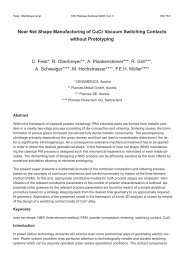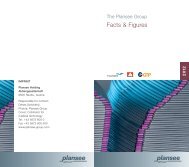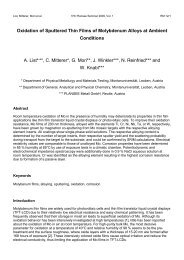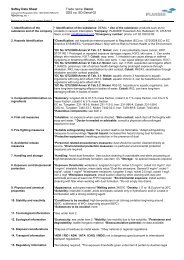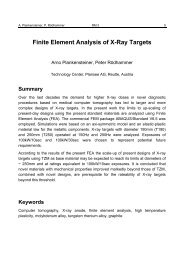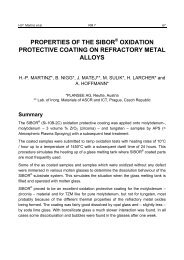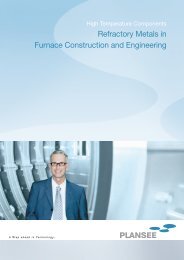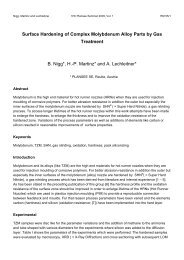Investigation of Solid Solution Hardening in Molybdenum Alloys
Investigation of Solid Solution Hardening in Molybdenum Alloys
Investigation of Solid Solution Hardening in Molybdenum Alloys
Create successful ePaper yourself
Turn your PDF publications into a flip-book with our unique Google optimized e-Paper software.
RM 18/4 17th Plansee Sem<strong>in</strong>ar 2009, Vol. 1 Wesemann, H<strong>of</strong>fmann et al.<br />
Table I: Overview <strong>of</strong> parameters and boundary conditions for the different theories describ<strong>in</strong>g SSH<br />
Parameter: Fleischer: Labusch: Suzuki:<br />
ε, Ew F<br />
p, q, Z<br />
τ c<br />
Boundary<br />
conditions<br />
ε = η′ + αδ * 2 2 2<br />
ε = η′<br />
+ α δ<br />
p = 3/2;<br />
q = 1/2;<br />
ZF = 760<br />
L<br />
p = 4/3;<br />
q = 2/3;<br />
ZL = 550<br />
E W<br />
G(<br />
T )<br />
= 0.<br />
122eV<br />
( 1.<br />
52δ<br />
+ η′<br />
′ ) ⋅<br />
G<br />
p = 2;<br />
q = 1<br />
2<br />
3<br />
1<br />
2<br />
1<br />
1 4<br />
Ew ⋅ c<br />
2<br />
2<br />
3<br />
τ cF = Gε<br />
F c τ G 3<br />
cL = ε L c<br />
τ cS = 3<br />
Z F<br />
Z<br />
kTb<br />
L<br />
b… Burgers vector<br />
T = 0K;<br />
c < 0.1%<br />
T = 0K;<br />
c > 0.1% possible<br />
T > 0K possible<br />
c > 0.1% possible<br />
valid for b.c.c. iron<br />
Reference [6, 8] [8] [8, 10]<br />
* for screw dislocations [14]<br />
Sample Preparation<br />
Alloy<strong>in</strong>g elements were selected with respect to the solubility limits <strong>in</strong> the molybdenum matrix, the<br />
availability and the limits were implied by the powder metallurgical manufactur<strong>in</strong>g route. Other important<br />
factors are chemical stability <strong>of</strong> the alloy<strong>in</strong>g elements dur<strong>in</strong>g the s<strong>in</strong>ter<strong>in</strong>g process <strong>in</strong> a hydrogen<br />
atmosphere, density after s<strong>in</strong>ter<strong>in</strong>g and sufficient deformability after s<strong>in</strong>ter<strong>in</strong>g <strong>in</strong> order to produce<br />
samples with a relative density >99.5%.<br />
Accord<strong>in</strong>g to these requirements molybdenum alloys with 0.5-3.0% chromium, 0.5 -5.0% rhenium, 0.5-<br />
3.0% tantalum, 0.5-4.0% titanium and 1.0-18.3% tungsten were produced by the manufactur<strong>in</strong>g route as<br />
listed <strong>in</strong> Fig. 2. All compositions are given on atomic percent.<br />
<strong>Molybdenum</strong> powder (Fischer Sub Sieve Size FSSS=4.7µm) was blended together with commercial<br />
available powders <strong>of</strong> chromium (FSSS





